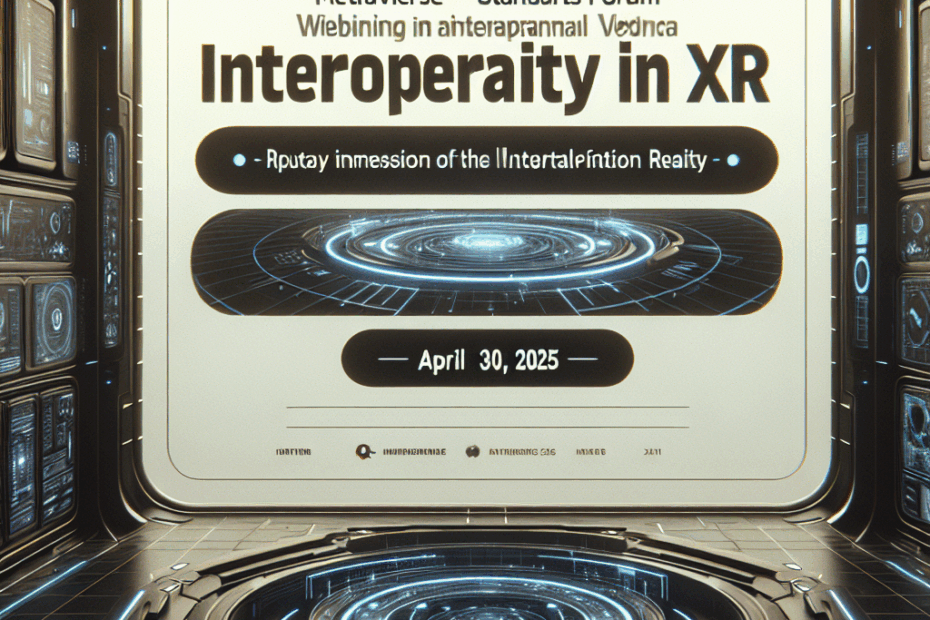🚀⚡️💰 Did you miss the XR Interoperability webinar? Discover the crucial role of interoperable anchoring in the Metaverse’s future! #XR #Metaverse #Interoperability
Explanation in video
“`html
Welcome to the Future of XR: Anchoring It All Together!
Hey everyone, John here! Today we’re diving into something super cool from the Metaverse Standards Forum: interoperable anchoring for XR. Don’t worry if that sounds like complete gibberish right now – we’ll break it down into bite-sized pieces. They had a webinar about it on April 30, 2025, which I attended virtually (of course!), and I’m excited to share what I learned.
What’s “Anchoring” and Why Should I Care?
Think of anchoring like planting a flag in the digital world. Imagine you’re playing a game where you build a virtual sandcastle on your living room floor using augmented reality (AR). Anchoring makes sure that sandcastle stays right where you built it, even if you walk around the room or turn off your device and come back later. It keeps virtual objects locked in place within the real world.
Without anchoring, your sandcastle might drift away, shrink, or even disappear! So, it’s pretty important for creating immersive and stable XR experiences.
What Does “Interoperable” Mean?
Okay, Lila has a question!
Lila: John, “interoperable” sounds like a complicated word. Can you explain it in a way I can understand?
Great question, Lila! “Interoperable” basically means things can work together, even if they’re from different companies or systems. Think of it like this: you should be able to use the same charging cable for your Android phone and your friend’s Android phone, even if they’re different brands. That’s interoperability! In the context of XR, it means that virtual objects anchored in one system can be recognized and used in another system.
XR – The Big Picture
Another question from Lila!
Lila: What exactly *is* XR, then? It sounds like a fancy abbreviation.
You’re right, it does! XR stands for “Extended Reality.” It’s an umbrella term that encompasses all kinds of immersive technologies, including:
- Virtual Reality (VR): This puts you in a completely computer-generated world using a headset. Think of games where you’re exploring alien planets or fighting dragons.
- Augmented Reality (AR): This overlays digital information onto the real world, usually through your phone or tablet. Remember Pokémon GO, where Pokémon appeared in your backyard? That’s AR!
- Mixed Reality (MR): This blends the real and virtual worlds together, allowing you to interact with both at the same time. Imagine designing a new kitchen in your actual kitchen, seeing virtual cabinets and appliances in place before you buy them.
So, XR is the all-encompassing term for these kinds of experiences.
Why Interoperable Anchoring is a Game Changer
Imagine you create a virtual painting in one AR app, and then you want to show it off in another AR app. Without interoperable anchoring, that painting might not appear correctly (or at all!) in the second app. Interoperable anchoring solves this problem by creating a common standard for how virtual objects are anchored in the real world. This means:
- Seamless Experiences: You can move virtual objects between different XR apps and platforms without any hassle.
- More Creativity: Developers can build on each other’s work, creating richer and more complex XR experiences.
- Wider Adoption: As XR becomes easier to use and more consistent, more people will be likely to adopt it.
The Metaverse Standards Forum’s Role
The Metaverse Standards Forum (MSF) is a group of companies and organizations working together to create open standards for the metaverse. Think of them as the people making sure all the different pieces of the metaverse puzzle fit together nicely. Their work on interoperable anchoring is a crucial step towards making the metaverse a reality.
Real-World Examples of Interoperable Anchoring
Let’s make this even clearer with some examples:
- Virtual Collaboration: Imagine architects from different firms collaborating on a virtual building design, using different software. Interoperable anchoring would allow them to see and interact with the same virtual model in the same virtual space, regardless of the software they’re using.
- Retail Experiences: You could use an AR app to virtually place furniture in your home, and then share that layout with a friend who uses a different AR app. The furniture would appear in the correct location in both apps, allowing you to get their feedback.
- Education and Training: Students could participate in a virtual science experiment, with different students using different VR headsets. Interoperable anchoring would ensure that everyone sees the same virtual environment and can interact with the same virtual objects.
My Thoughts, and Lila’s Too!
The idea of seamlessly moving virtual objects between different XR experiences is really exciting. It feels like we’re one step closer to a truly interconnected metaverse. I think this is a key component to making the Metaverse useable and something people will actually want to use!
Lila: Wow, John, that actually makes sense! I’m starting to see how all these different pieces of the metaverse are coming together. It sounds like interoperability is key for making the metaverse user-friendly. Now, if only I could get my virtual sandcastle to stop drifting away…
This article is based on the following original source, summarized from the author’s perspective:
Towards Interoperable Anchoring for XR
“`
